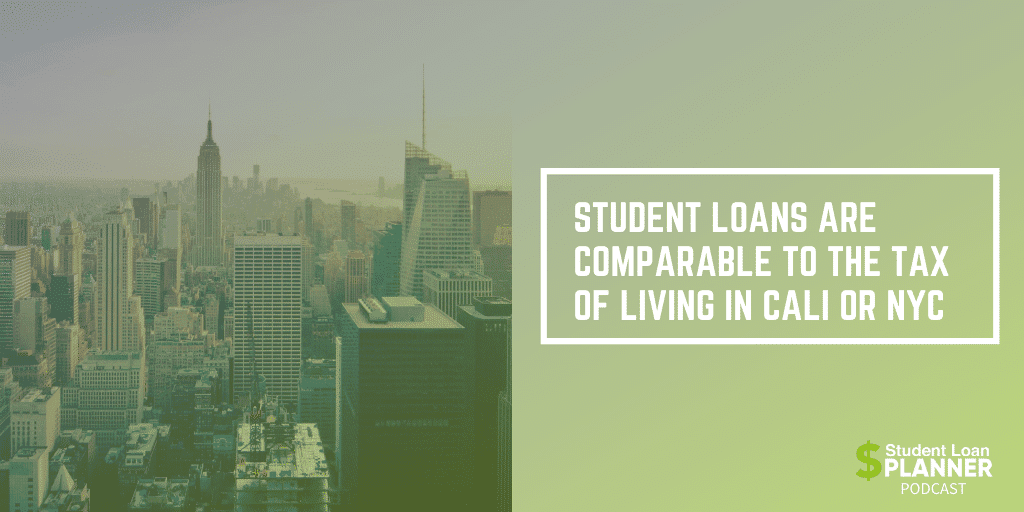
It’s no secret that a college education can unlock higher earning potential than if you had just gone to high school. But what about the student debt?
From the perspective of what you’ll have to pay on your student loans, the worst that can happen isn’t any different than being a resident of California or New York City. It’s because student loans aren’t actually a debt. It’s more like a tax you pay on the income you earn. I’ll explain more about that in a minute.
Student loans aren’t a debt sentence. If you have a plan in place, life can be pretty good with student loans.
Flight to quality in education
The average person in America is relatively risk-averse. People tend to flock to quality and stability in their lives, whether through a secure position with a company, investments, or material possessions.
Part of this flight to quality includes people pursuing a higher quality education. A college education can lead to career stability. Instead of being stressed about your job, you can focus on the things that matter the most to you.
The high cost of education
The federal government doesn’t limit how much you can borrow. The government will let you borrow as much as the school asks for. It’s driving up costs and causing education to become ridiculously expensive.
But the school also knows how student loan repayment works. Instead of the old system requiring you to pay 1% of what you borrow each month, schools know that you can pay 10% of your income when you graduate. No matter how high your student loan balance is, your repayment on federal student loans doesn’t have to be more than 10% of your income.
And that’s why student loans are like a tax.
Why student loans are like a tax
California has amazing weather. People often say the sunshine and blue skies make them decide to move to California and build their lives there. The same goes for New York City, although it’s more likely the culture and entertainment that draw people to the Big Apple.
The downside is that the cost of living is generally higher. But here’s the thing: the benefits of living in a place like California or New York City are so great that people don’t mind paying more money to live there.
In fact, an average middle-class person living in California pays roughly 10% in taxes. New York City has a 6% state tax and a 4% local tax, which totals about 10% there.
The same is true for student loans. You can choose to pursue a higher quality education and pay 10% of your income as a student loan payment. But there’s a difference for student loans: your balance is forgiven after ten years with Public Service Loan Forgiveness (PSLF) or 20 or 25 years with some of the other income-driven repayment (IDR) plans.
An example of student loans as a tax
Let’s say Cindy is a chiropractor that lives in Florida. She earns $50,000 per year and has $250,000 in student loan debt. Cindy is on an IDR plan that lets her pay 10% of her income for her monthly student loan payment.
But it isn’t 10% of her total income – it’s 10% of her discretionary income. When she subtracts retirement contributions and other options to lower her adjusted gross income, her payment ends up being closer to 6% of her total earnings.
Even if Cindy saves 8% of her income to pay the tax bomb that will come due when her loans are forgiven in 20 years, she’s still only putting about 14% of her income toward student loans.
Florida doesn’t have a state income tax, which means Cindy is living the same life as someone with no student loans in California or New York.
Student loans aren’t a debt at all
If your income is about the same as (or more than) your student loan balance, you can treat your student loans like a debt. It’s best to refinance to a lower interest rate and pay them off as fast as possible.
But what if your student loan balance is more than your income? It can feel overwhelming and like you’ll never get out of debt. Except it isn’t as bad as you think.
The worst-case scenario is your debt is like a tax. The majority of people pay 8% to 12% of their income for 10, 20, or 25 years, similar to income taxes in California and New York City. After that, any remaining balance is forgiven, and the debt goes away forever.
If you don’t have a plan to repay your student loans, I encourage you to book a consult with one of our student loan consultants. It could change your life.
Not sure what to do with your student loans?
Take our 11 question quiz to get a personalized recommendation for 2024 on whether you should pursue PSLF, Biden’s New IDR plan, or refinancing (including the one lender we think could give you the best rate).
